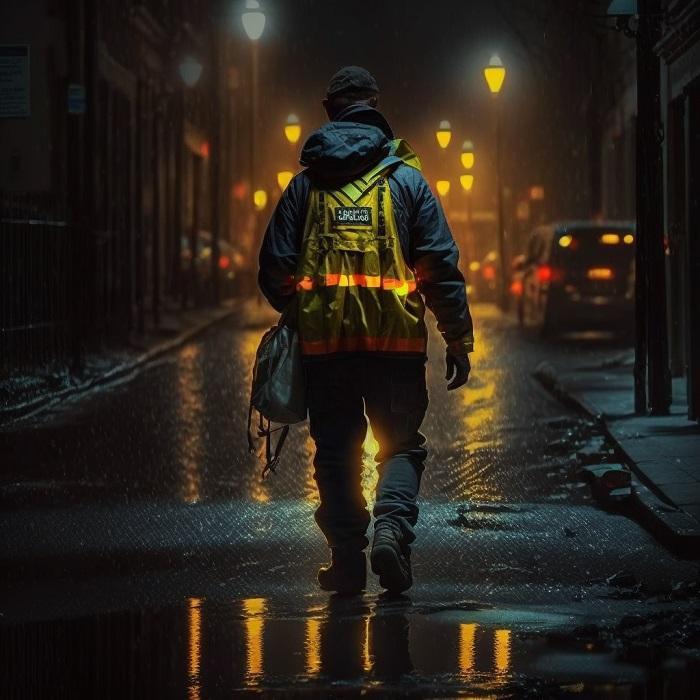One of the habits I developed over the pandemic was to take walks at night. I live in a fairly safe, low-density neighborhood. I understand there is a greater risk involved with walking at night and i accept that risk. At the same time, I also work hard to mitigate that risk by doing things like wearing a reflective vest and making sure my dog has a flashing LED collar. I think walking at night can be a great way to get some exercise and fresh air, but it’s also important to take precautions to stay safe. I’ve written the following article as a guide for making walking at night a little safer.
Let’s start with some basic dos and don’ts.
Do’s:
- Walk in Well-Lit Areas: First, it’s essential to walk in well-lit areas. Stay in parts of your neighborhood or other locations that offer lighting and limit dark areas. Stick to pedestrian pathways or sidewalks when walking at night.
- Walk on the Sidewalk: If possible, walk on the sidewalk. But if there’s no sidewalk available, walk against traffic. This allows you to see what is coming in advance and allows yourself time to react to danger.
- Remain Alert: Another essential “do” is to remain alert. Always stay alert and watch for cars, animals, and other people. If you feel like something isn’t right or are uncomfortable walking through a particular area, don’t doubt yourself.
- Carry a Whistle or Pepper Spray: It’s also a good idea to carry a whistle, pepper spray, or other protective (legal) item that will allow you to defend yourself against an attack. And don’t forget to carry a flashlight to help you see your surroundings when walking at night and allow others to see you.
- Wear Reflective Clothing: It’s a good idea to wear reflective clothing. It looks dorky, but wouldn’t rather be alive and look like a dork than be run over dead? Always make sure you are highly visible and alert while walking.
- Vary Your Route and Schedule: Additionally, it’s best to vary your route and your schedule. Mix up your times for walking and take different routes.
Dont’s: On the other hand, some “don’ts” include the following:
- Don’t Wear Dark clothing: Instead, wear reflective gear such as sashes or badges that have reflective material on them, or wear bright clothing such as neons or whites.
- Don’t Interact with Stranges: It’s also best to avoid engaging with strangers while walking at night. Keep your distance from strangers, don’t stop to chat, and don’t be distracted by anyone. Even if they seem friendly, you never know what their intentions might be.
- Don’t Wear Headphones: And, it’s important to avoid using headphones while walking. This affects your ability to detect sounds around you, and it is important to remain maximally alert while walking at night.
- Don’t Walk in a Bad Neighborhood: Avoid walking in a high-crime area.
- Don’t Walk Late at Night: Nothing good happens after 11 or 12 p.m., more people are drinking and driving, driving fatigued, so just don’t do it.
Additional tips:
Now, let’s move on to some additional tips to help keep you safe while walking at night. One of the most important things you can do is plan your route ahead of time to avoid getting lost and to walk with confidence. Make sure someone else knows your plans and can send help if you don’t arrive at your destination on time. Always carry your phone and download a safety app that can discreetly alert the authorities if you feel threatened or see something suspicious.
Being aware of your surroundings is essential when walking at night. Keep an eye on everything happening around you, including the people, cars, and buildings. Being vigilant can help you avoid potential danger. If you feel that something isn’t right or you sense danger, trust your instincts and avoid taking unnecessary risks. For example, if you see a group of people hanging out on the street corner, it’s best to take a different route. Don’t take any risks that could put you in danger.
It’s also important to avoid taking unnecessary risks. If you feel that something isn’t right or you sense danger, trust your instincts and take steps to protect yourself. For example, if you see a group of people hanging out on the street corner, it’s best to take a different route. Don’t take any risks that could put you in danger.
Finally, to reiterate, if you ever feel uncomfortable or threatened, don’t hesitate to seek help or call the authorities. It’s always better to be safe than sorry, and there’s no shame in asking for help when you need it.
Conclusion
Walking at night can be a great way to get some exercise and fresh air, but it’s important to take safety precautions to avoid potential dangers. By following the dos and don’ts for walking at night, as well as the additional tips provided, you can minimize your risk of harm and enjoy a safe and peaceful nighttime walk. Remember to always stay alert, stay in well-lit areas, carry a protective item, and avoid engaging with strangers. Trust your instincts, and if you ever feel uncomfortable or threatened, don’t hesitate to seek help or call the authorities. By taking these simple steps, you can enjoy the many benefits of walking at night without compromising your safety. Safety should always be your number one priority, so take the necessary precautions and enjoy your nighttime walks with peace of mind.
Safe Lifting in Construction Environments: 10 Tips for Businesses


